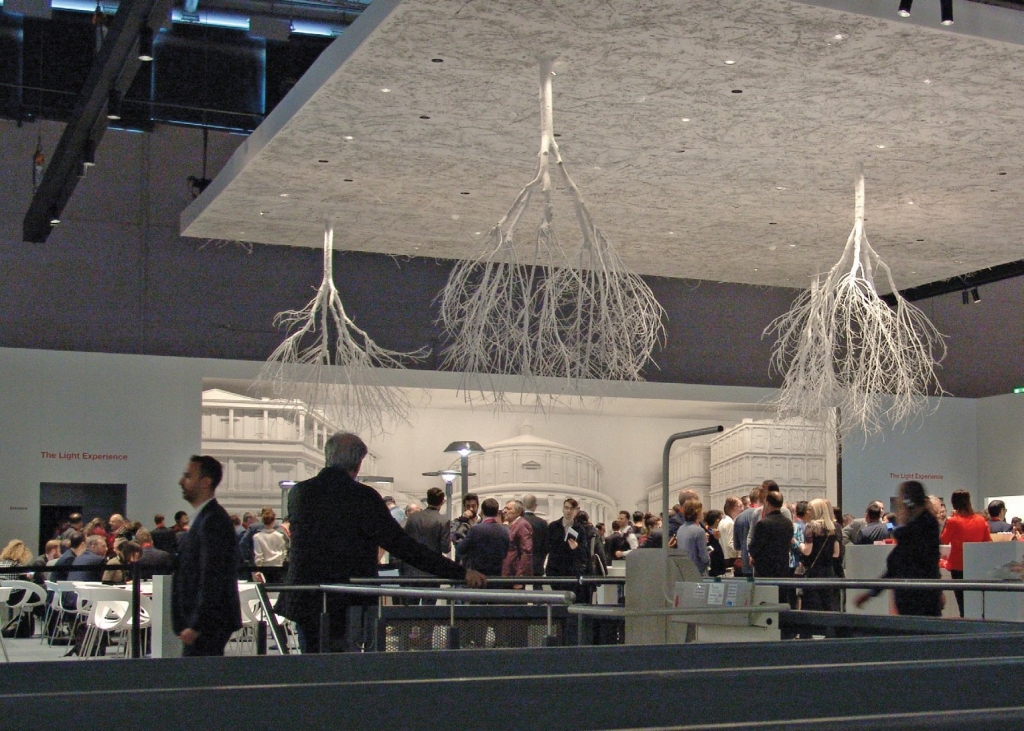Light+Building, which took place in Frankfurt, Germany March 18-23, claims to be world’s largest lighting show. For its 2016 edition, 2,589 exhibitors from 55 countries occupied 2.76 million sq. ft. of tradeshow-floor space; approximately 216,000 visitors from 160 countries visited the show.
Diodes rule
When I walked the show two years ago, the full spectrum of lightsources – incandescents, fluorescents, high-intensity discharge (HID) fixtures, a few neon tubes and, of course, LEDs – was represented. However, to paraphrase the theme of fixture manufacturer iGuzzini’s (Renecanti, Italy) tradeshow booth, the world of lighting has been turned upside-down.
Across the whole fairground, I couldn’t find a single fluorescent lamp (except the exhibit-hall lights), compact-fluorescent fixture (except an HID-replacement, 100W model offered by a Chinese manufacturer) or neon tube. I counted HID-lamp vendors on one hand. Otherwise, the show featured nothing but LEDs.
If LEDs are now monopolizing the sign industry, how will Light+Building fill 22 halls in the future?
Undoubtedly, LEDs have advanced by more than a quantum leap in the last two years. One major improvement is in the quality of white light they render, which is measured through color rendering in combination with high efficacy. In 2014, only one or two LED manufacturers had color-rendering indices (CRI) of 96 or higher when operating in the 40-70 lumens/W range. Today, modules operating at 136 lumens/W deliver a CRI of 98. Clearly, LEDs have surpassed standards established by triple-phosphor, fluorescent lamps.
However, LED-lit, fluorescent-replacement products offered in two Light+Building halls occupied by Chinese manufacturers revealed numerous inconsistencies. The vendors sold them in bulk – and, frankly at cheap, cutthroat prices – and a closer look revealed big differences in quality of light (read: CRI), brightness, efficacy and safety.
Buyer beware
When I evaluated retrofit-lamp vendors, I noted that only large, reputable manufacturers indicated the problems in achieving a UL listing, which I’ve discussed in a previous column (see ST, March 2015, page 36), that are associated with the use of modern lamps in old fixtures. When asked, most vendors of bargain-priced LEDs said they didn’t know about listing issues.
Some of these exhibitors have clearly improved their marketing. In 2014, most less reputable companies, including many from Asia, manned 10 x 10-ft. booths with only a table, chairs and two spotlights. Their booths were as indistinct as their modules. However, at this Light+Building show, their booths were as stylish as what you’d see at any US show. In some cases, they were even as appealing as booths operated by European vendors.
The LED-filament replacements offered for “old style” incandescent lightbulbs used for signs and interior-lighting fixtures matched the color and brightness of traditional bulbs rather well. They’re suitable for programming flashing and chasing sequences. However, some bulbs’ operating temperatures render them incompatible for outdoor use; read the datasheets carefully.
Billboard signs are lit almost exclusively by HID lamps. In 2014, the most powerful LED operated with 180W and emitted 11,500 lumens within a 1.5-in. diameter. At this show, a demo LED of the same size used 1kW of power, and put out 170,000 lumens. From Citizen, a Japanese manufacturer (http://ce.citizen.co.jp), you can buy a 530W unit with 70,000 lumens that’s generated from a 1.5-in. disc. That translates to 130 lumen/W and a CRI over 70.
OLEDs
In contrast, organic LEDs (OLED) have improved in intensity over the past four years, but not such that they can yet be regarded as a signage option. All booths showing OLEDs were wrapped in black velvet cloths, which make OLEDs appear artificially bright. The OLED module sizes on display measured 3 x 8 in. at most. They might be sufficient for backlighting an LCD operating panel, but are insufficient for sign lighting.
Remote control
Lighting control through networked systems, also known as “smart lighting,” was another aspect applicable to signage. For wired lighting systems, LED power supplies use either the DALI protocol or the KNX (EIB) bus. The known analog 1-10V system is available, but not considered contemporary; I’ve reviewed control systems in a previous column.
For wireless communication, Bluetooth has seemingly evolved into the standard, with software applications accessible via smartphones and tablets. This technology is focused on home and office lighting, with rather short distances and indoor communication.
For example, the Megaman Co. (www.megaman.cc) demonstrated an LED lightbulb replacement with a standard Edison-bulb base that’s linked to a smartphone’s Bluetooth dimming control. Its color temperature changes with the dimming to match that of an incandescent lamp.
However, Bluetooth technology is barely applicable for sign-lighting control, in my opinion. It offers a secure communication for a very short maximum distance. Even LED power supplies with Wi-Fi internet connections (I did not check all datasheets, but none were advertised as Wi-Fi-controllable) didn’t seem to provide a range for which wireless control (to set operating time or light intensity for a roof sign, for example) would be of interest. Such systems may eventually adopt Internet of Things technology, which will alleviate the distance problem.
Nearly 49% of Light+Building attendees came from other countries to explore new products, ideas and techniques – including those related to the sign industry. With the growth of LED options, it pays to use caution (and closely examine spec sheets) when making purchasing decisions.



 Tip Sheet3 days ago
Tip Sheet3 days ago
 Business Management1 week ago
Business Management1 week ago
 Women in Signs2 weeks ago
Women in Signs2 weeks ago
 Real Deal4 days ago
Real Deal4 days ago
 Editor's Note1 week ago
Editor's Note1 week ago
 Line Time2 weeks ago
Line Time2 weeks ago
 Product Buying + Technology1 week ago
Product Buying + Technology1 week ago
 Women in Signs4 days ago
Women in Signs4 days ago







